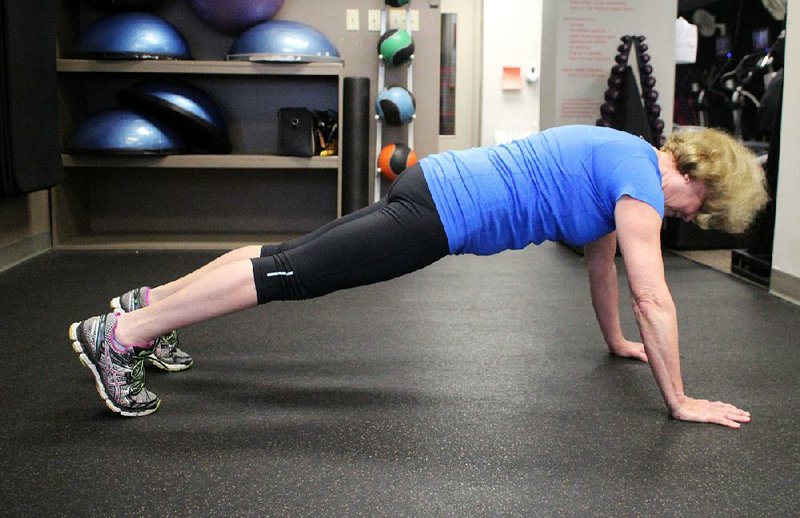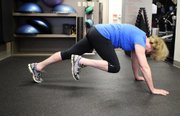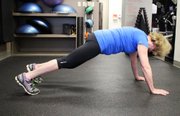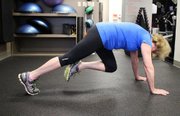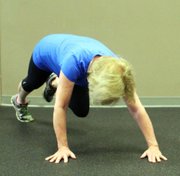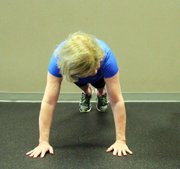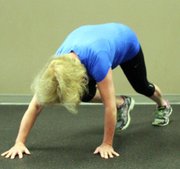Body-weight training is often dismissed as something that's more suited for super-fit gym rats capable of knocking out 20 pullups without even breaking a sweat. Maybe it started out that way, but it has evolved a great deal over the past decade or two.
This week, I'll present a few tips for incorporating appropriate body-weight training into your routine -- without going overboard. Plus, I'll introduce a spinoff of one of my all-time favorite body-weight exercises, the mountain climber.
Most people think of pull-ups, dips and pushups when they hear the term "body-weight training." While these exercises certainly fit the description, there are many other options that aren't nearly as difficult for the average exerciser. In addition, there are dozens of variations of each body-weight exercise that can make it possible for anyone to perform.
The first step is to evaluate your strength-to-weight ratio. It's not necessary to break out the calculator or get all "technical" with this step, but it is important to understand your overall capabilities. Can you do a pushup? How about a pullup? Do you get winded walking up stairs? Answering such questions is an easy way to get a rough idea of your strength-to-weight ratio. (There are more technical methods, but I'll save those for another time.)
Most people will fall somewhere in between "I can't do a single pushup" and "pushups make me sleepy." To arrive at more clarity, perform as many pushups as you can in one minute. If your hands are shoulder-width apart and you're balancing on your toes (for men) and knees (for women), just keep pressing out the pushup until you reach 60 seconds. The American College of Sports Medicine publishes charts that assign skill levels like "good" and "fair" for both sexes in various age brackets based on how many pushups can be done in a minute, but the goal here is to get a general idea of your ability to move your body.
Write down how many pushups you did and think about it. Once you've done this, you'll have a sense of your overall strength-to-weight ratio. Whether it's poor or excellent, keep that information handy when you design your body weight program. If you struggled to do one or two pushups in 60 seconds, don't plan an exercise program that calls for two sets of 10 pushups in your first workout.
Start with exercises that are at the low end of the difficulty spectrum. Mountain climbers, body-weight squats and body-weight lunges are good examples of low-intensity body-weight exercises.
As you begin to integrate these exercises, remember that they become more difficult with larger ranges of motion. A full squat is much tougher than a half squat. As you grow comfortable with the movements, try to perform each in a complete range of motion. Then, start tossing in variables that make it more difficult. For example, a squat or a lunge can be tweaked by adding a "hop" at the top of the movement.
This week's exercise is an easy variation that makes the mountain climber tougher. The Semicircle Mountain Climber will challenge the upper body, lower body and core muscles throughout this simple motion.
1. Get into the "up" phase of a pushup with both arms extended and your feet 12-18 inches apart.
2. Begin performing normal mountain climbers by bringing one knee toward the chest, then replacing your foot while you simultaneously bring the other knee toward the chest.
3. Pump both legs in a rapid but controlled fashion.
4. Keep your hands in place and start "walking" your lower body to the right as you continue the climbers.
5. Move the lower body about 2 feet to the right and then reverse direction.
6. Move the lower body to the left until you're about 2 feet past your starting point.
7. Continue moving back and forth while performing the climbers for 30 to 40 seconds.
This exercise is a great way to warm up before your upper-body training. Not only will you increase the heart rate, but the upper-body muscles will activate and prepare for activity.
Remember, body-weight exercises can be challenging and fun at the same time.
Matt Parrott has a doctorate in education (sport studies) and a master's in kinesiology and is certified by the American College of Sports Medicine.
vballtop@aol.com
ActiveStyle on 11/23/2015
